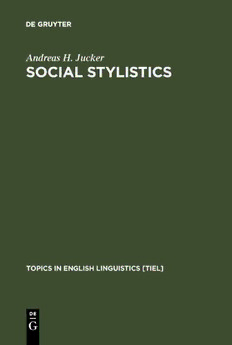
Social Stylistics: Syntactic Variation in British Newspapers PDF
Preview Social Stylistics: Syntactic Variation in British Newspapers
Social Stylistics Topics in English Linguistics 6 Editors Jan Svartvik Herman Wekker Mouton de Gruyter Berlin · New York Social Stylistics Syntactic Variation in British Newspapers Andreas H. Jucker Mouton de Gruyter Berlin · New York 1992 Mouton de Gruyter (formerly Mouton, The Hague) is a Division of Walter de Gruyter & Co., Berlin. © Printed on acid-free paper which falls within the guidelines of the ANSI to ensure permanence and durability. Library of Congress Cataloging in Publication Data Jucker, Andreas H. Social stylistics : syntactic variation in British news- papers / Andreas H. Jucker. p. cm. — (Topics in English Linguistics ; 6) Includes bibliographical references and index. ISBN 3-11-012969-8 (alk. paper) 1. British newspapers — Language. 2. Journalism — Great Britain — Language. 3. English language — Great Britain — Style. 4. English language — Great Britain — Syntax. 5. English language — Great Britain — Variation. 6. English language — Social aspects — Great Britain. I. Title. II. Series. PE1474.J8 1992 O72'.014-dc20 91-45888 CIP Die Deutsche Bibliothek — Cataloging in Publication Data Jucker, Andreas H.: Social stylistics : syntactic variation in British newspapers / Andreas H. Jucker. — Berlin ; New York : Mouton de Gruyter, 1992 (Topics in English linguistics ; 6) ISBN 3-11-012969-8 NE: GT © Copyright 1992 by Walter de Gruyter & Co., D-1000 Berlin 30 AH rights reserved, including those of translation into foreign languages. No part of this book may be reproduced or transmitted in any form or by any means, electronic or mechanical, including photocopy, recording, or any information storage and retrieval system, without permission in writing from the publisher. Typesetting: Satzpunkt, Braunschweig Printing: Arthur Collignon GmbH, Berlin. Binding: Lüderitz & Bauer, Berlin. Printed in Germany. To Stefan and Fabian 's grandparents Contents List of tables xi List of figures xv Preface xvii Abbreviations xxi 1. Introduction 1 2. Variability in sociolinguistics and stylistics 11 2.1. Introduction 11 2.2. Three approaches to the concept of style 12 2.2.1. Traditional stylistics 12 2.2.2. Ethnography of speaking 16 2.2.3. Correlational sociolinguistics 18 2.2.4. The sociolinguistic triangle 19 2.3. The notions "variety" and "style" 21 2.4. Stylistic variation 26 2.5. Audience design 28 2.6. Some recent studies in media language 32 2.6.1. Crystal and Davy - "Journalese" versus "normal" English 32 2.6.2. Carter and Ghadessy - Newspaper vocabulary 34 2.6.3. Ferguson - Sports announcer talk 36 2.6.4. Wallace - Sports versus news section 37 2.6.5. Floreano - British newspapers and radio news 39 2.6.6. Ryden and Bell - Determiner deletion 40 2.6.7. Verschueren - Metapragmatic metaphors 41 2.6.8. Lüger - Newspaper text types 43 2.6.9. Conclusion 45 3. Socio-economic differentiation of the British dailies 47 3.1. "Qualities" and "populars" 47 3.2. Readership profiles 48 3.3. Differences in appearance and coverage 56 3.4. Conclusion 58 4. Structure of noun phrases 59 4.1. Introduction 59 4.2. Premodification 60 4.3. Postmodification 68 4.3.1. Relative clauses 69 4.3.2. Appositive clauses 70 4.3.3. Nonfmite clauses 71 viii Contents 4.3.4. Postmodification by prepositional phrases 75 4.3.5. Postposed adjectives 77 4.3.6. Appositions 77 4.4. Multiple modifications 80 5. Noun phrases as style markers 83 5.1. Introduction 83 5.2. Noun phrase variables in paradigmatic relationships 83 5.2.1. Relative clauses 84 5.2.2. Genitive versus o/-construction 89 5.3. Premodifier variation 91 5.4. Complexity as style marker 93 5.5. Conclusions and hypotheses 102 6. Distribution and complexity 107 6.1. Introduction 107 6.2. The density of modifiers 108 6.3. Multiple modifications and modifier embedding 110 6.4. Noun phrase complexity in the three newspaper categories 114 6.5. Noun phrase complexity in the five newspaper sections 125 6.6. Cluster analysis 132 7. Premodifications 137 7.1. Types of premodifiers 138 7.1.1. Precentral 138 7.1.2. Central 140 7.1.3. Postcentral 142 7.1.4. Prehead 143 7.2. Stylistic significance of premodifier variation 148 7.3. The individual styles 152 7.3.1. The sports section 154 7.3.2. The home-news and foreign news sections in the down- and mid-markets 157 7.3.3. The business section in the down-and mid-markets 161 7.3.4. The arts section in the up-markets 164 7.3.5. The business, home news and foreign news sections in the up-markets 169 7.4. Summary 175 8. Postmodifications 177 8.1. Types of postmodifiers 177 8.1.1. Non-verbal postmodifiers 179 8.1.2. Non-finite verbal postmodifiers 183 8.1.3. Finite verbal postmodifiers 184 Contents ix 8.2. Stylistic significance of postmodifier variation 184 8.3. The individual styles 186 8.3.1. The sports section 187 8.3.2. The home-news and foreign news sections in the down- and mid-markets 190 8.3.3. The business section in the down- and mid-markets 194 8.3.4. The arts section in the up-markets 196 8.3.5. The business, home news and foreign news sections in the up-markets 200 8.4. Summary 203 9. Noun phrase name appositions 207 9.1. Introduction 207 9.2. The honorific-title-appositive gradients 213 9.3. Previous studies 216 9.4. Linguistic constraints 223 9.4.1. The semantic constraints 223 9.4.2. The syntactic constraints 226 9.5. Social constraints 230 9.6. Noun phrase name appositions in the sports section 239 9.7. The structure of the name in appositions 242 9.8. Summary 249 10. Conclusion 251 Notes 257 Appendix I Coding scheme 259 Appendix II Corpus 261 Appendix HI Tables 273 A.3 Readership profiles 273 A.6 Noun phrase complexity 274 A.7 Premodification 276 A.8 Postmodification 277 A.9 Apposition formats 278 References 281 Index 293
